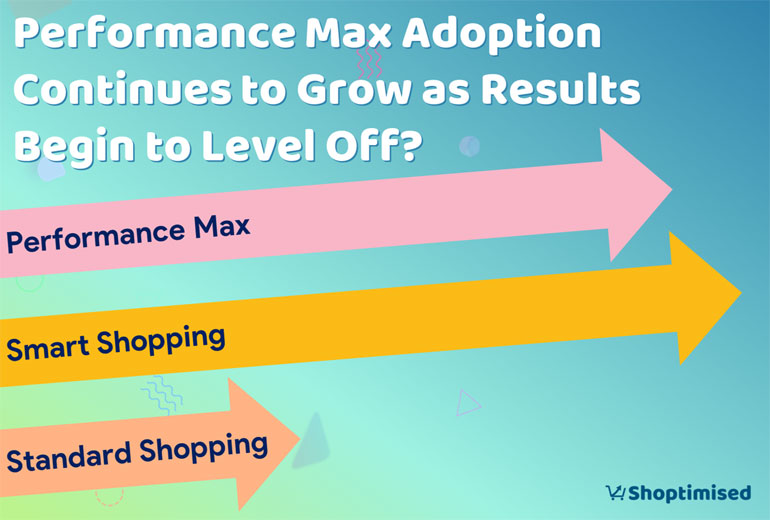
Performance Max Growth
Using data aggregated from 2,179 Google Ads accounts we have been able to track how much Google Shopping budget has spent via Performance Max, Smart Shopping and Standard Shopping.
Spend in Performance Max campaigns has almost doubled when comparing Quarter 2, 2022 (31.95%) against Quarter 1, 2022 (16.77%). It appears that most of the Performance Max growth is coming from retailers and agencies switching from Smart Shopping which could be in part driven by the Google Migration process.
Standard Shopping also saw a small increase in spend during Quarter 2 as agencies and retailers most likely sought more control and transparency.
Performance Max Results
Whilst Performance Max delivered a better ROAS and higher Average Order Value than Standard or Smart Shopping during Quarter 1, 2022 results dropped in Quarter 2, 2022 with Performance Max and Smart Shopping having an identical ROAS (we double, and triple checked that!) and an almost identical Average Order Value.
Both Smart and Performance Max continue to outperform Standard Shopping, but it is concerning to see Performance Max results dropping as more retailers and agencies start switching over.
We wondered whether adoption was causing Performance Max results to drop or is it just down to how it’s being set up? It’s difficult to answer either conclusively and the adoption questions will require a lot more time to answer conclusively. But we did take a deeper dive into the use of Target ROAS within Performance Max campaigns.
You can see from the results that most Performance Max campaigns are utilising or being hampered by (depending on which camp you sit in) a Target ROAS. Performance Max campaigns that did not use a Target ROAS achieved a higher ROAS and a better Average Order Value.
We know from our own testing that utilising a Target ROAS can restrict your reach and reduce your revenue. In a lot of instances, Target ROAS is not used correctly or updated and changed far too frequently which constantly resets your learning period. You read more about that here.
Q: Is the best approach to managing Performance Max to simply remove the Target ROAS settings?
For some agencies and retailers, that would be a very uncomfortable thought and it’s not something we would suggest unless you had control over your product feed so you could build and utilise performance data.
We developed a solution for this approach 4 years ago which we call Performance Rules. Our Performance Rules let you pull data from your Google Shopping and utilise that data to create better campaign structures, one example of such is below…
These campaign structures utilise a theory by Google called Business Objectives and are more focused on working to compliment your business goals as opposed to just setting one Target ROAS and seeing what you get back.
Whilst the above is just one example, there are many ways you can structure campaigns based on the data you input and utilise within your Product Feed. In addition to Google Shopping performance data, the Cost of Goods Sold attribute can help you to create profit margins.
The newer Sell on Google Quantity attribute can be utilised to pass stock data to ensure campaigns either focus on well stocked products or this information can be combined with other attributes such as Size or Colour to exclude low stock product ranges.
When more data is utilised at a Product Feed level to enhance your campaign strategy, it gives you more control over Performance Campaigns and the ability to step away from using Target ROAS settings.
Other campaign factors within Performance Max such Ad Assets and Audiences can have an impact too. At Shoptimised we prefer to use neither, we have found this approach keeps 97% of the Performance Max traffic focused on Shopping.
Watch the webinar in our previous approach to Performance Max set up blog.
Once you add in Ad Assets, the amount of Search and Display traffic starts to increase. This means your brand traffic can be potentially pulled into Performance Max which will greatly improve results whilst the Display traffic will most likely lower results. But the combination of them both evens out and due to the lack of visibility, there is no way to know what traffic volume is going through Search and Display.
You can however, work out how much traffic is going through your Shopping Ads. Simply note the clicks, revenue, conversions etc of your Performance Max campaign(s).
Then go to Reports > Predefined Reports (Dimensions) > Shopping > MC ID and add into your columns, Conv Value, Conversions etc.
Now you can easily calculate the difference and understand how much of your traffic is going via Shopping.
Standard Shopping Growth
The growth in Standard Shopping campaigns piqued our interest and we had one question we wanted to answer…
Q: How much of the Standard Shopping spend is managed under Manual CPC bidding vs automated bid strategies?
As you can see from the above, the answer is very little. It seems that we are all mostly happy to let Google either fully automate or at least partially automate (Enhanced CPC) our bidding, even with Standard Shopping campaigns.
If we then look at the spend across all 2,179 Google Ads accounts, 89.9% of the spend (exclude Manual CPC and Enhanced CPC) was utilising a fully automated Google Bid Strategy. Enhanced CPC made up 8.91% of the spend and Manual CPC bidding accounted for just 1.24%.
The data (so far) backs up what Google claim, that their automation can drive better results.
So, it begs the question, what is putting off the remaining 20% from moving over to Performance Max?
We think the answer must be due to a desire for greater transparency and search term data, something we would all love back please.
Monthly Subscription